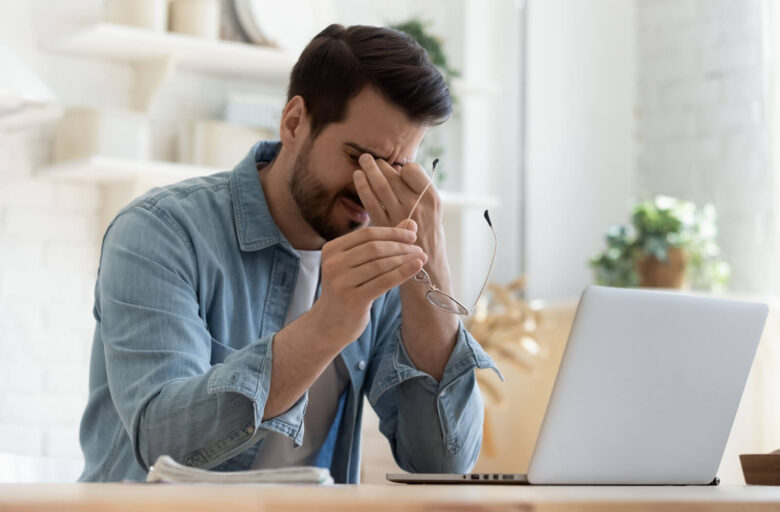In the modern digital workplace, the glare of computer screens is as constant as the sky. Technology has enabled extraordinary productivity, but it has also brought with it the silent problem of screen fatigue. Burning eyes, splitting headaches, foggy thinking, and constant fatigue are all symptoms of this condition, which can hinder both physical and mental health and professional performance. This article goes beyond simply “take a break” and explores digital eye strain and cognitive fatigue. We discuss research-based solutions for these underlying issues, from ergonomic workplace optimization to digital mindfulness. This approach will help you transform your relationship with technology, regain your focus, and create sustainable energy for the workday.
Understanding the Science Behind Screen Fatigue
Screen fatigue (also called digital eye strain or computer vision syndrome) is a complex condition with multiple causes. Digital screens emit high-energy visible (HEV) blue light, which scatters more easily than other light, reducing contrast and making it harder for our eye muscles to focus. The result can lead to dry eyes, blurred vision, and headaches. When we stare at a screen, we blink about 50% less often, accelerating the evaporation and drying of tears. From a cognitive perspective, the constant stream of notifications, emails, and messages forces our brains to maintain a state of partial attention, depleting mental reserves and leading to afternoon fatigue and reduced productivity.
Mastering Ergonomics and Lighting in the Workplace
The physical environment is essential for reducing screen fatigue. Ergonomics isn’t just about comfort; it’s also about reducing stress by adjusting the distance between your body and the screen. Position the top of your monitor at eye level or slightly lower so you don’t have to bend your neck when looking down. Keep the screen at arm’s length to prevent muscle strain. Lighting is also crucial. Bright overhead light and strong window glare force your pupils to constantly adjust. To diffuse the light, position your desk perpendicular to a window and use blinds or curtains. Instead of bright overhead lights, choose small, adjustable desk lamps for task lighting to create a softer, more balanced work environment.
Use the Advanced 20-20-20 Rule and Eye Exercises
The 20-20-20 rule—look at an object 20 feet away for 20 seconds every 20 minutes—is good advice, but we can be more proactive. Set a timer to remind you to look up and do a short eye exercise. After every hour of focused work, take a minute for a palm massage: massage your palms to generate warmth and then gently place them on your closed eyes without applying pressure to soothe your eye muscles. The figure-eight exercise is also a good exercise: imagine a large figure eight lying on your side, 3 feet in front of you, and follow its movement for 30 seconds in each direction. This short pause can effectively relieve eye muscle stiffness and improve lubrication.
Optimize Your Digital Environment with Software
Powerful hardware and software settings can help combat screen fatigue. The most significant change is enabling night light or blue light filters on all devices. This feature is automatically activated in the evenings and during the week to reduce blue light that can disrupt your sleep. To prevent squinting, you can significantly increase the text size and contrast on your screen. For text-intensive users, consider using Atkinson Hyperlegible or OpenDyslexic as your primary font. Finally, use your operating system’s zoom options to magnify details on the screen and reduce eye strain.
Scheduling Deep Work and Strategic Breaks
Continuous screen time can lead to cognitive fatigue. The modern “always-on” work culture contributes to fatigue. Therefore, schedule time for deep work and strategic breaks. Set aside 60—90 minutes for undisturbed work on your most demanding tasks. To create these undisturbed blocks, close your email tabs, turn off your phone notifications, and use a website blocker. After your block, take a 10- to 15- minute break. Don’t check social media on your phone. Put all electronic devices away. Take a walk, stretch, look out the window at a distant object, or make a cup of tea. Time away from screens helps your brain recharge, consolidate knowledge, improve productivity, and reduce mental fatigue.
Creating a Personalized Screen Fatigue Prevention Plan
Managing screen fatigue should be personalized and consistent. First, review your symptoms throughout the week to determine when your eyes or brain feel tired and which tasks are most tiring. Use this data to develop an ideal workday, including ergonomics, software, and break strategies. Use lubricating eye drops daily to keep your eyes hydrated. Drinking enough water promotes tear production, while consuming omega-3 fatty acids and antioxidants contributes to the long-term health of your eyes. Don’t see the guidelines as a set of rules, but as a tool for creating a better and more sustainable digital work life.
Conclusion
Our digital age contributes to screen fatigue, but the phenomenon doesn’t necessarily have to lead to serious consequences. By recognizing the complexities of the problem, we can implement a holistic approach. Every decision we make, from workplace design to cognitive resource allocation, can benefit our health and careers. These research-based methods can help you take control of your screen and transform it into a tool you can use with confidence. We strive for a balance where you maintain your health while working, without compromising it due to screen reflection.
FAQs
1. Are blue light blocking glasses necessary and effective?
Research on blue light blocking glasses has yielded conflicting results. They can reduce glare and filter some high-energy electron radiation (HEV), but limiting screen brightness and avoiding screen time before bed can improve sleep. Optimizing night light settings for better daytime work can help. They can alleviate headaches and eye strain for some users and therefore offer potential broader benefits.
2. What’s the most effective change I can make now?
The quickest and most effective change is to enable night lights or blue light filters on my computer and phone. Set a start time in the early afternoon and stick with it. This simple software adjustment can minimize the main source of visual fatigue without cost or disrupting productivity.
3. How do I forget to take breaks while concentrating?
I don’t have enough willpower. Set an automatic timer. Apply the 20-20-20 rule and use a Pomodoro app, a vibration function on my smartwatch, or a kitchen timer to extend strategic breaks. This external trigger is necessary to develop a consistent habit.
4. Will screen fatigue damage my vision in the long term?
There is no evidence that screen fatigue causes permanent vision damage. However, chronic fatigue can cause discomfort and worsen vision problems. Physical discomfort indicates the need to adjust habits. Reducing screen fatigue is crucial for comfort and relief from chronic headaches, but it does not lead to permanent vision loss.
5. Do screen users need supplements or nutrients for eye health?
A nutritious diet helps protect the eyes. Leafy greens like kale and spinach contain the antioxidants lutein and zeaxanthin, which contribute to retinal formation. Flaxseed and oily fish contain omega-3 fatty acids, which contribute to tear production. Vitamins A, C, and E are also essential. While a balanced diet is recommended, people can also take supplements, but consult a doctor first.




